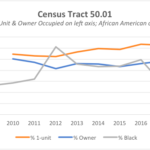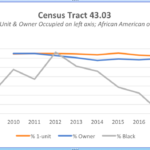According to The Nation magazine and progressive urban planners, my census district shouldn’t exist.
According to them, urban single-family zoning not only perpetuates historical racial segregation, but is designed to do exactly that, even now in the year 2019.
Which makes it hard to explain my census tract, Denver 50.01. According to 2017 Census estimates, this half square-mile piece of real estate in eastern Denver has about 1100 housing units, over 75% of which are single-unit detached, and another 17% are single-unit attached. Nearly 80% of the tract is owner-occupied. And an estimated 10% of the residents are black.

Denver as a whole is roughly 10% black, and my census tract matches the city average. What’s more, the 9.9% estimate from 2017 is nearly 50% lower than the average for the previous five years. Remember, over 90% of the housing stock is single-unit attached or detached, and that percentage has increased slightly since 2011.
Anyone with even a passing familiarity of Denver history knows its fractured racial past. In the 1920s, the place was a hotbed of Klan activity. More recently, from 1973 to 1994, Denver had public school busing. In the run-up to that, the buses were torched and the home of the most actively pro-busing school board member, Rachel Noel, was firebombed.
But while race provided for some contentious times in Denver’s past, the idea that neighborhoods with single family housing had anything to do with it doesn’t hold up to scrutiny.
Consider a neighboring tract to the northwest, 40.03. This census tract, and with about a 25% higher median household income, has historically averaged over 7% African American, with over 90% single-unit detached housing and around 90% owner-occupancy. It is roughly the same density as my own tract, with an estimated 2360 units on almost precisely one square mile.

This was the census tract where neighbors banded together to oppose a 27-unit condo development, and were risibly called racist for it. Both the higher percentage of African Americans in 2012 and the vanishingly small number in 2017 may well be a result of sampling error. Regardless of the reason, 2017’s numbers can hardly be indicative of a historical trend that vanished entirely for the preceding decade. Admittedly, there’s a difference between a community being racist and a law having disparate impact, but in this case, one isn’t true and therefore the other makes no sense: people who want to keep a place lily-white are going to choose to live in a lily-white place to begin with.
None of this says that racism in Denver is a thing of the past. It does suggest that the housing policies that the progressives hate so much, housing policies that allow people to have some space of their own, without living literally on top of one another, aren’t racist and don’t perpetuate de facto racial segregation.
Otherwise, my census tract couldn’t exist.
Joshua Sharf is a Denver resident and a fiscal policy analyst at the Independence Institute.


